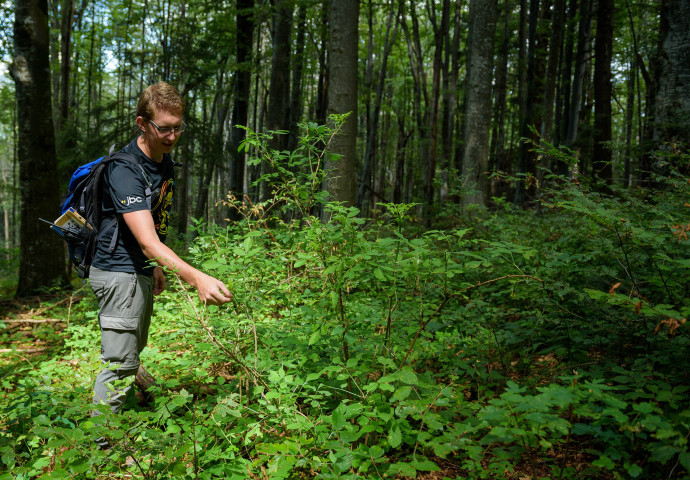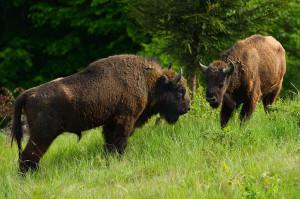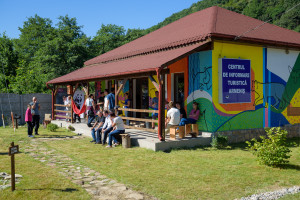Over the last four months, I have been doing my internship in the Southern Carpathians rewilding area in Romania. This internship was part of my Master study of Biology at the Wageningen University in The Netherlands. One of my professors connected me with Rewilding Europe where he suggested to me to check out their rewilding project in the Southern Carpathians. After being in touch with the Romanian rewilding team, it became clear that they could really use an intern student this summer, so I went for it!

In the beginning of June 2016, I arrived in a small and rural Romanian village called Fenes. Here, most of the people are working on their small land properties in the surrounding hills. With only one primary school, a few shops and a small monastery, many people spend their free time by sitting in front of their houses, watching as days go by. At first sight, it seemed like nothing special was happening there, but there is!

Fenes is home to the research station of the Southern Carpathians rewilding team, working on the return of the European bison into this wild part of the Carpathian Mountains. Since this year, this initiative is co-funded through the LIFE project “Urgent actions for the recovery of European bison populations in Romania” (LIFE Bison) financed by the European Commission. The plan is to built a viable and healthy population of bison that is free to roam this largest European mountain range. At least a hundred bison will be released here in the coming five years. The bison reintroduction takes place in stages, where small herds are first released into a small enclosure with a so-called acclimatization zone. After a few months they will then go into the the adjacent rewilding zone of 150 ha, before being released into the wild.
Just a few days after my arrival, 20 bison that were in the rewilding zone near the town of Armeniș were set free. It was great to be present at the release event and witness this big step forward in the project. Shortly afterwards, a new group of 10 bison arrived originating from the Belgian Bellewaerde Zoo, and the German Wisentgehege bison reserve and Neumünster wildlife park to be released during the following months. Television crews from CNN, Belgium and Romania joined this event together with involved project partners and locals. It was great to see how many people are interested and involved in this project!

With the first group of bison enjoying their freedom, I was able to start my research. As the animals are new to the area, I wanted to find out how they behave in the wild. Therefore, it was highly important to find out which places and habitats the bison prefer. Would they move to the higher elevated mountain forests and grasslands or would they maybe stick around the local farms and pastures? Data collection would not only provide information about habitat use and how the animals would roam the area; it would also help prevent possible human-bison conflicts. And last but not least, it would also help to identify additional reintroduction sites in the Southern Carpathians in order to support the establishment of a healthy bison population.
I used the available methods to collect data on where the bison were hanging around. I analysed GPS data from collared bison, videos from camera traps in the study area, and coordinates from indirect bison observations by performing transects and other hikes. These indirect observations included the bison tracks and dung, but also the markings they make on trees, as the bison like to nibble on the bark of young beech and fir saplings.

Every time I went up into the mountains doing my fieldwork and research I felt privileged to be working in such a beautiful and wild place. Each week I hiked several tens of kilometres through the area, covering as much ground as possible to track the bison and conduct my research.
The bison are not the only wildlife roaming the area. Camera traps have captured species of deer, wild boar, wolf, brown bear, and even the illusive Eurasian lynx! One time I even had a close encounter with a large mammal, hiding just 20 meters away in a dense beech-seedling patch. Although I could not see what was running away from me, I found very fresh bear scats just a hundred meters away! Besides the fact that this was quite exciting it was actually very useful, as I was able to collect samples for another study on genetic diversity of the brown bear in the Southern Carpathians!
After collecting all the data I needed, I made an analysis using statistical and GIS-software and I found several ‘hotspots’ where bison-activity was very high. Interestingly, some bison often found in these hotspots preferred pasture habitats and spend more than 70% of their time in this habitat type. Remarkably, these findings differ from studies on habitat use of the free bison in Poland, where they spent most of their time in forest habitats (where they are often fed during winter time, to keep them in the forest habitat). However, not all the bison were in pastures, as many tracks were found in other (open) forest areas, indicating that another part of the group is further expanding its home range and exploring the area. This is promising news and I hope the bison will continue exploring the area to find their way across the mountains in the next years.

Besides doing research on the bison, the project is also focusing on other aspects like supporting the development of local enterprises linked to the bison, raising awareness about rewilding and nature conservation, and developing nature-based tourism in the area. During my time in Romania, I’ve helped to set up a weekly movie-night for the local youth, where we mixed educative nature related documentaries with Disney movies to keep the kids involved and familiar with the project. In addition, the visitor centre that opened up this summer in the neighboring Armeniș village, has state of the art installations displaying science to anyone interested. It even hosts Europe’s biggest hologram-projection, where you can see a virtual bison moving around.
The LIFE Bison project has proven to me to be special and unique, and the Southern Carpathians rewilding area a place you must visit if you are interested in the European wilderness! The project enables people to stand at the frontline of nature conservation and learn about its beauty and challenges. Personally, I have learned a lot and I was happy to be able to teach and spend time with people involved in the project. I am sure that various special events will take place in the upcoming years, so I would warmly recommend to Europeans to support and visit this magnificent place in the green heart of Europe. I would like to thank Rewilding Europe and WWF Romania for giving me the opportunity to join their work and be part of making Europe a wilder place!
